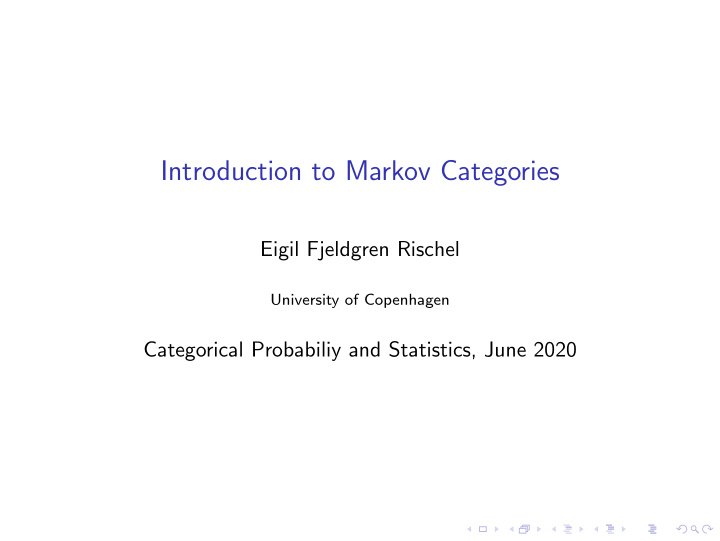



Introduction to Markov Categories Eigil Fjeldgren Rischel University of Copenhagen Categorical Probabiliy and Statistics, June 2020
TLDR ◮ Consider a category where the maps are “stochastic functions”, or “parameterized probability distributions”. ◮ This is a symmetric monoidal category ◮ Many important notions in probability/statistics are expressible as diagram equations in this category. ◮ We can axiomatize the structure of this category to do “synthetic probability”. ◮ Several theorems admit proofs in this purely synthetic setting.
Overview of talk Introduction Diagrams for probability Markov categories Kolmogorov’s 0 to 1 law Sufficient statistics
A graphical model (Figure stolen from Kissinger-Jacobs-Zanasi: Causal Inference by String Diagram Surgery)
Independence A map I → X ⊗ Y is a “joint distribution”. When are the two variables “independent”? ◮ If the distribution is the product of the marginals. ◮ If you can generate X and Y separately and get the same result.
Deterministic What does it mean that f : X → Y is deterministic? “If you run it twice with the same input, you get the same output”.
Markov categories A Markov category (Fritz 2019) is a category with the structure to interpret these examples: a symmetric monoidal category with a terminal unit and a choice of comonoid on every object. (These have been considered by several different authors)
Examples of Markov categories ◮ Stoch: measurable spaces and Markov kernels. ◮ FinStoch: finite sets and stochastic matrices. ◮ BorelStoch: Standard Borel spaces and Markov kernels. ◮ Gauss: Finite-dimensional real vector spaces and stochastic processes of the form “an affine map + Gaussian noise”. ◮ SetMulti: Sets and multivalued functions . ◮ More exotic examples.
Kolmogorov’s 0 to 1 law (classical) Theorem(Kolmogorov) Let X 1 , X 2 . . . be an infinite family of independent random variables. Suppose A ∈ σ ( X 1 , . . . ) ( A is an event which depends “measurably” on these variables), and A is independent of any finite subset of the X n s. Then P ( A ) ∈ { 0 , 1 } . Example: A is the event “the sequence X i converges”. The theorem says either the sequence converges almost surely, or it diverges almost surely.
Digression: Infinite tensor products An “infinite tensor product” X N := � n ∈ N X n is the cofiltered limit � � X F := � of the finite tensor products n ∈ F X n F ⊂ N finite if this limit exists and is preserved by tensor products − ⊗ Y An infinite tensor product is called a Kolmogorov product if all the projections to finite tensor products π F : X N → X F are deterministic. (This somewhat technical condition is necessary to fix the comonoid structure on X N )
Kolmogorov’s 0 to 1 law (abstract) With a suitable definition of infinite tensor products, we can prove: Theorem(Fritz-R) Let p : A → � i ∈ N X n and s : � i ∈ N X i → T be maps, with s deterministic and p presenting the indepenence of all the X s. Suppose in each diagram � i ∈ F X i is independent of T . Then sp : A → T is deterministic. Applying this theorem to BorelStoch recovers the classical statement.
Proof(sketch) ◮ First, we see that T is independent of the whole infinite product X N as well. ◮ This statement means that two maps A → X N ⊗ T agree. ◮ By assumption the codomain is a limit, so it suffices to check that all the projections A → X N ⊗ T → X F ⊗ T agree. ◮ This is true by assumption. ◮ A diagram manipulation now shows that T , being both independent of X N and a deterministic function of it, is a deterministic function of A .
Sufficient statistics ◮ A “statistical model” is simply a map p : Θ → X . ◮ A “statistic” is a deterministic map s : X → V . ◮ A statistic is sufficient if X ⊥ Θ | V That means that we have α such that
Fisher-Neyman Classically: Suppose we are in “a nice situation” (measures with density...) Fisher-Neyman Theorem A statistic s ( x ) is sufficient if and only if the density p θ ( x ) factors as h ( x ) f θ ( s ( x )) Abstract version: Suppose we are in “a nice Markov category”. Then: Abstract Fisher-Neyman (Fritz) s is sufficient iff there is α : V → X so that α sp = p , and so that s α = 1 V almost surely.
Thank you for listening! Some papers mentioned: ◮ Fritz(2019): A synthetic approach to Markov kernels, conditional independence and theorems on sufficient statistics arxiv:1908.07021. ◮ Fritz-R(2020): Infinite products and zero-one laws in categorical probability arxiv:1912.02769 ◮ Jacobs-Kissinger-Zanasi(2018): Causal inference by String Diagram Surgery arxiv:1811.08338
Recommend
More recommend